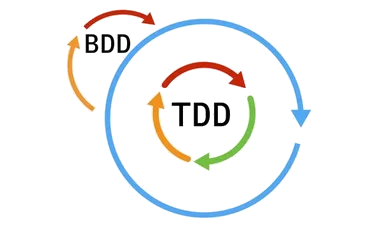Behavior-Driven Development (BDD) is a transformative approach that’s making waves across organizations. Let’s delve into what BDD is, its impact, and how it differs from Test-Driven Development (TDD).
Understanding Behavior-Driven Development (BDD):
BDD is a software development methodology that focuses on defining the behavior of a system from the user’s perspective. It emphasizes collaboration between developers, testers, and non-technical stakeholders like product managers and business analysts. At its core, BDD aims to ensure that the software being developed aligns with user needs and business goals.
Impact on Organizations:
1. Enhanced Collaboration: BDD fosters clear communication among cross-functional teams. By using a common language to describe system behavior (often using Gherkin syntax), BDD bridges the gap between technical and non-technical team members. This collaboration leads to a shared understanding of requirements, reducing misunderstandings and rework.
2. Customer-Centric Development: BDD shifts the focus from writing code to delivering value. It encourages teams to prioritize features based on user needs, ensuring that the software addresses real-world scenarios. This customer-centric approach enhances product quality and user satisfaction.
3. Early Issue Identification: BDD encourages the creation of executable specifications or scenarios before writing code. This practice helps teams identify potential issues and ambiguities early in the development process, reducing costly defects and rework later on.
4. Continuous Feedback: BDD promotes a feedback-driven development cycle. Teams can quickly validate whether their code meets the expected behavior, allowing for rapid iterations and improvements.
BDD vs. Test-Driven Development (TDD):
While BDD and TDD share similarities, they have distinct differences:
Focus: BDD emphasizes the behavior and outcomes of the system from a user’s perspective. TDD focuses on testing individual units or components of the code.
Audience: BDD involves non-technical stakeholders, such as product owners and business analysts, in defining behavior. TDD primarily involves developers writing tests for their code.
Language: BDD uses natural language (e.g., Gherkin) to describe behavior, making it accessible to non-developers. TDD tests are typically written in programming languages.
Scope: BDD tests are broader and encompass end-to-end scenarios. TDD tests are more granular and target specific functions or methods.
In conclusion, Behavior-Driven Development (BDD) isn’t an alternative to TDD, but rather BDD fills in the cracks in testing coverage TDD misses. By aligning teams, enhancing collaboration, and prioritizing user needs, BDD empowers organizations to deliver software that truly makes a difference to end users’ experiences.


